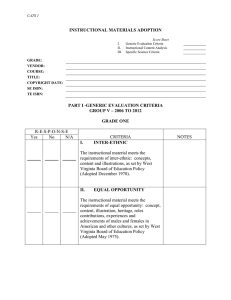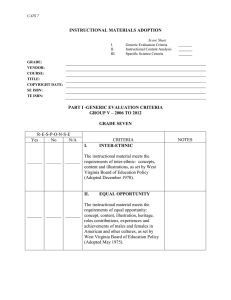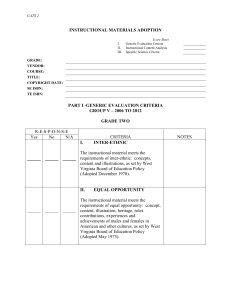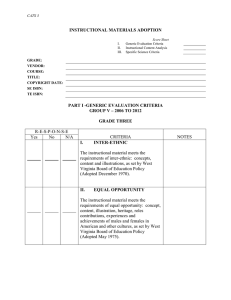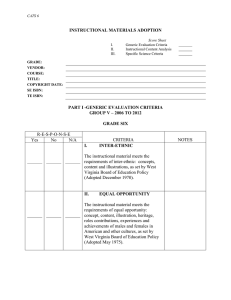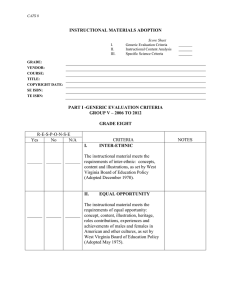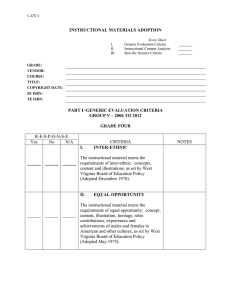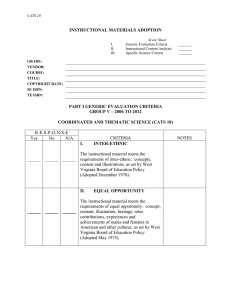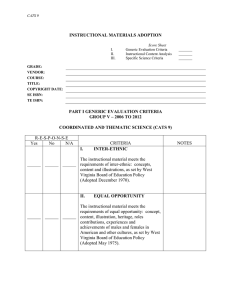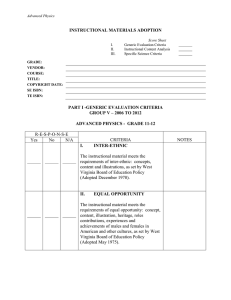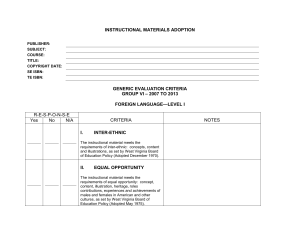INSTRUCTIONAL MATERIALS ADOPTION PART I -GENERIC EVALUATION CRITERIA
advertisement
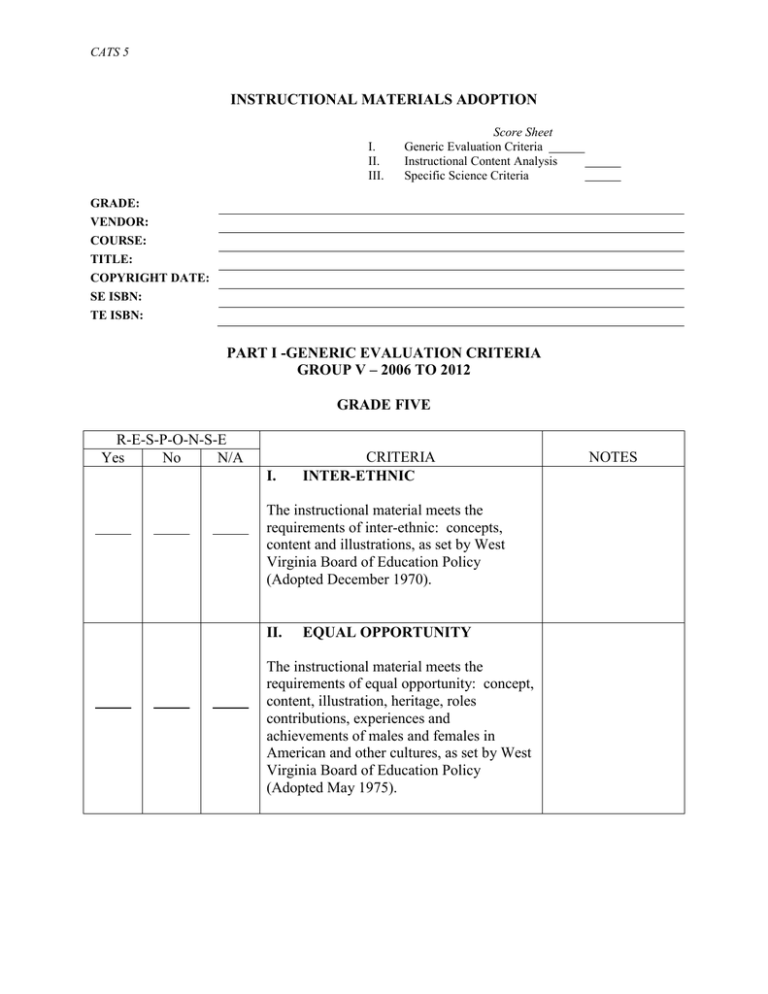
CATS 5 INSTRUCTIONAL MATERIALS ADOPTION I. II. III. Score Sheet Generic Evaluation Criteria Instructional Content Analysis Specific Science Criteria GRADE: VENDOR: COURSE: TITLE: COPYRIGHT DATE: SE ISBN: TE ISBN: PART I -GENERIC EVALUATION CRITERIA GROUP V – 2006 TO 2012 GRADE FIVE R-E-S-P-O-N-S-E Yes No N/A I. CRITERIA INTER-ETHNIC The instructional material meets the requirements of inter-ethnic: concepts, content and illustrations, as set by West Virginia Board of Education Policy (Adopted December 1970). II. EQUAL OPPORTUNITY The instructional material meets the requirements of equal opportunity: concept, content, illustration, heritage, roles contributions, experiences and achievements of males and females in American and other cultures, as set by West Virginia Board of Education Policy (Adopted May 1975). NOTES CATS 5 Part II – Instructional Content Analysis GRADE FIVE (Vendor/Publisher) SPECIFIC LOCATION OF CONTENT WITHIN PRODUCT (IMR Committee) Responses I=In-depth 80% A=Adequate 80% M=Minimal 60% N=Nonexistent Less than 60% I A M N The instructional materials program presents information and opportunities in a manner that enables the student an understanding of: 1. 2. History and the Nature of Science a. demonstrate an understanding that scientists formulate and test their explanations of nature using observation and experiments b. demonstrate an understanding of careers and contributions of men and women of diverse cultures to the development of science Science as Inquiry a. the instructional materials program presents information and opportunities that support a minimum of 50% active inquiry, investigations and hands-on activities b. cooperate and collaborate to ask questions, find answers, solve problem, conduct investigations to further an appreciation for scientific discovery c. formulate conclusions through close observations, logical reasoning, objectivity, perseverance and integrity in data collection d. apply skepticism, careful methods, logical reasoning and creativity in investigating the observable universe e. use a variety of materials and scientific instruments to conduct explorations, investigations and experiments of the natural world CATS 5 (Vendor/Publisher) SPECIFIC LOCATION OF CONTENT WITHIN PRODUCT (IMR Committee) Responses I=In-depth 80% 3. 4. 5. A=Adequate 80% M=Minimal 60% N=Nonexistent Less than 60% f. demonstrate safe techniques for handling, manipulating and caring for science materials, equipment, natural specimens and living organisms g. utilize experimentation to demonstrate scientific processes and thinking skills h. construct and use charts, graphs and tables to organize, display, interpret, analyze and explain data Unifying Themes a. compare and contrast the relationship between the parts of a system to the whole system b. construct a variety of useful models of an object, event or process c. compare and contrast changes that occur in an object or a system to its original state d. identify the influence that a variation in scale will have on the way an object or system works Scientific Design and Application a. research everyday applications and interactions of science and technology b. implement engineering solutions for given tasks and measure their effectiveness Science in Personal and Social Perspectives a. explore the connections between science, technology, society and career opportunities b. analyze the positive and negative effects of technology on society and the influence of societal pressures on the direction of technological advances I A M N CATS 5 PART III - SPECIFIC CRITERIA GRADE FIVE The Coordinated and Thematic Science Grade Five (CATS 5) objectives evaluate, interpret and predict conditions and phenomena of the living and designed worlds. Through a spiraling, inquiry-based program of study, all students will demonstrate scientific literacy in the fields of biology, chemistry, physics and earth/space sciences. The subject matter is delivered through a coordinated, integrated approach with an emphasis on the development of the major science themes of systems, changes and models. Students will engage in active inquires, investigations, and hands-on activities for a minimum of 50% of the instructional time to develop conceptual understanding and research/laboratory skills. Safety instruction is integrated in all activities (Vendor/Publisher) SPECIFIC LOCATION OF CONTENT WITHIN PRODUCT (IMR Committee) Responses I=In-depth 80% 1. 2. 3. 4. A=Adequate 80% M=Minimal 60% N=Nonexistent Less than 60% Science Subject Matter/Concepts Objectives a. demonstrate an understanding of the inter-connections of biological, earth and space and physical science concepts (SC.5.4.1) Structure and function in Living Systems a. identify and explain common energy conversions (SC.5.4.2) b. identify the structures of living organisms and explain their function (SC.5.4.3) c. observe and identify cells of organisms using microscope (SC.5.4.3) Life Cycles of Organisms: Reproduction and Heredity a. compare variations of plant growth and reproduction (SC.5.4.3) Populations and Ecosystems a. explain how the different characteristics of plants and animals help them to survive in different niches and environments including adaptations, natural selection and extinction (SC.5.4.6) I A M N CATS 5 (Vendor/Publisher) SPECIFIC LOCATION OF CONTENT WITHIN PRODUCT (IMR Committee) Responses I=In-depth 80% 5. 6. 7. 8. A=Adequate 80% M=Minimal 60% N=Nonexistent Less than 60% b. explore the extinction of a species due to environmental conditions (SC.5.4.7) c. trace and describe the pathways of the sun’s energy through producers, consumers and decomposers using food webs and pyramids (SC.5.4.8) Properties of Objects and Materials a. explain that the mass of a material is conserved whether it is together in parts or in a different state (SC.5.4.9) b. recognize that elements are composed of only one type of matter (SC.5.4.10) c. using the periodic table, identify common elements according to their symbols (SC.5.4.11) d. compare the relative density of substances by their ability to float and sink (SC.5.4.12) Light, Heat, Electricity and Magnetism a. analyze diagrams of electrical circuits (SC.5.4.13) b. use SI (metric) measurement units of volts, amps and watts as they apply to electricity (SC.5.4.14) c. investigate the properties of an electromagnet (SC.5.4.15) Position and Motion of Objects a. describe how the variables of gravity and friction affect the motion of objects (SC.5.4.16) b. compare and contrast the change in length, tension or thickness of a vibrating object on the frequency of vibration (SC.5.4.17) Structure of the Earth System a. describe the layers of the earth and their various features (SC.5.4.18) b. identify and describe natural landforms (SC.5.4.19) I A M N CATS 5 (Vendor/Publisher) SPECIFIC LOCATION OF CONTENT WITHIN PRODUCT (IMR Committee) Responses I=In-depth 80% 9. A=Adequate 80% M=Minimal 60% N=Nonexistent Less than 60% c. describe how weather and climate are changed by natural landforms (SC.5.4.19) d. use a variety of instruments and sources to collect and display weather data to describe weather patterns. Data collected should be temperature, wind direction, wind speed and precipitation (SC.5.4.21) e. compare and explain the different rates of weathering, erosion and deposition in certain materials (SC.5.4.21) f. identify land features and elevations on a topographical map (SC.5.4.22) g. identify resources as being renewable or non-renewable (SC.5.4.23) Earth’s History a. explore and explain how fossils and geologic features can be used to determine the relative age of rocks and rock layers (SC.5.4.24) b. identify that the Earth is made of plates (SC.5.4.25) I A M N
